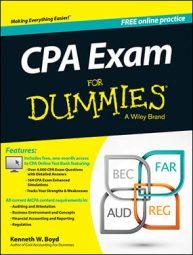Trust and estate taxation questions on the Regulation (REG) test of the CPA exam require you to know several complex formulas. You should understand concepts related to distributable net income, tax calculation for trusts, and taxation of estates.
Here are some important terms the REG test may cover:
Principal (corpus): Principal is the assets that make up the trust or estate. The principal is also referred to as the corpus.
You can connect this definition of principal with the bond definition of principal (the amount a borrower repays at maturity).
Beneficiary: The beneficiary is the person who receives the principal from the trust or the person who is entitled to the benefit of the corpus.
Fiduciary: A fiduciary is a person put in a position of trust. A trustee is a fiduciary for a trust, and an executor is a fiduciary for an estate. A fiduciary has a duty to hold and invest the principal amount and also to allocate and distribute income generated by the trust or estate investments.
Donors (those who gift assets) are assessed a gift tax; however, for trusts and estates, taxes are assessed on the beneficiary. This difference reinforces a key point: Suppose an individual decides not to use a trust or set up the documents for an estate plan.
Instead, the taxpayer decides to transfer assets to people only by gifting assets while he or she is still alive. Instead of having the beneficiary pay taxes, the taxes are paid when the assets are gifted.
Introducing distributable net income
Distributable net income (DNI) calculates the taxable portion of the principal, income, and capital gains generated by a trust or estate. Trusts and estates complete IRS Form 1041. Here is the DNI formula:
DNI = Adjusted gross income + Tax – Exempt interest – Deductions – Capital gains
Here are definitions for each of the DNI terms:
Adjusted gross income (AGI): This amount includes all the income generated by the trust or estate. AGI includes taxable interest earned on investments, dividend income, royalties, and fees earned. This amount is different from AGI for a personal tax return.
Tax-exempt interest: Income from tax-exempt municipal bonds is added to compute DNI, just as tax-exempt interest is added back to net income to compute the alternative minimum tax (AMT). In both cases, tax-exempt interest is added to compute taxable income.
Deductions: Charitable contributions are deducted from the DNI formula. The trust or estate can also deduct business expenses, such as accounting and legal costs associated with the trust. Fees paid to the executor or trustee can also be deducted.
Capital gains: Capital gains are added to the principal of the trust, not to income. If the trustee sells 100 shares of General Electric stock in the trust for a $3,000 gain, that gain is added to the principal of the trust.
Trust taxation
Here are the two types of trusts that are most often tested:
Simple: A simple trust requires that the principal amount remain in the trust. All the income must be distributed to the beneficiary. A simple trust doesn’t allow for a charitable deduction for tax purposes.
Complex: If you set up a complex trust, you’re allowed to distribute the principal as well as the income generated from the trust. However, you don’t have to distribute all the income generated. The complex trust is allowed a charitable deduction.
The taxation of a trust is based on the distributable net income. The ability to move principal or income out of the trust doesn’t determine taxation. For example, a complex trust may be taxed on income that isn’t distributed to a beneficiary.
Working on estate taxation
The REG test focuses on estate issues that occur when the individual passes away. The event is referred to as death of the decedent. As with trusts, an estate is taxed on the income generated in the estate. When the individual passes away, Form 706 needs to be filed. The return is due with any tax liability payment within months of the decedent’s death.
The executor or a person designated by the executor compiles the tax return. The executor has a choice to make on the value of the assets. The estate’s assets can be valued on the date of death or six months after the date of death.
The estate tax return can be viewed as a two-step process. First, an accountant computes the tentative tax. Then the tentative tax is adjusted for any gift taxes paid and the unified credit to compute the net estate taxes due. You’ll see that, at death, the estate tax calculation combines the estate tax with gift taxes already paid.
First, here is the formula for the tentative tax:
The gross estate is the entire value of the estate’s property. This value is based on the valuation method chosen (date of death or six months after death). Estates have allowance deductions, such as tax and legal fees and fees to the executor.
The formula adds any gifts that are taxable. After you add the items to compute the tentative tax base, you multiply the tax base by the estate tax rate to compute the tentative tax.
The second formula, net estate tax due, takes the tentative tax and adds in the impact of any gift taxes paid and the unified credit:
The unified credit offsets a taxpayer’s gift and estate tax liabilities. As of this writing, a taxpayer can give away up to $5 million during his or her lifetime and not pay any gift tax.
Keep in mind that most REG test questions on this topic won’t ask you for this entire calculation. Instead, a question may give you some of these numbers and ask for a portion of one calculation.

